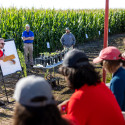Chazen presents print, collage exhibition
From Oct. 17–Jan. 3, the Chazen Museum of Art will exhibit the twisting, jumbled topography of artist Nicola López.
![[photo] Urban Transformation #5.](http://www.news.wisc.edu/story_images/1557/original/Lopez_UrbanTransformation5_.jpg)
Nicola López, “Urban Transformation #5,” etching, lithography, and woodcut, 30 × 30 in.
A preview reception and artist talk will be held from 5:30–8 p.m. on Friday, Oct. 16, at the Chazen. There will be music by Tapas Musicales, as well as refreshments and a cash bar.
One might be tempted to call López a landscape artist, but not in any traditional understanding of the words. The works in “Nicola López: Urban Transformations” are not pastoral rural scenes but unpredictable urban worlds built with the imagery of debris from the manufactured, technological world.
López’s artwork ranges from small prints and collages to larger-than-life installations. Her primary media are drawing, intaglio, woodcut and photolithography. She prefers drawing and printmaking because they reflect both the trace of the artist’s hand and the automation and mass production we rely on to create our modern world.
Her works are complex: She mixes media and often constructs three-dimensional collages and installations from cut-out and repieced prints. By reconfiguring the urban environment, López creates a wondrously messy and dizzying new place. Her works are exaggerated and many-layered, a cumulative territory reflecting cycles of building, demolition and rebuilding. Her perspective often puts the viewer in the center of this tangled landscape, immersed in the refuse of cast-off and reused objects.
![[photo] Under Its Own Weight.](http://www.news.wisc.edu/story_images/1559/original/Lopez_UnderItsOwnWeight_pr.jpg)
Nicola López “Under Its Own Weight,” 2006, woodblock on Mylar, steel armature, 12 × 11 × 7 ft.
In “Nicola López: Urban Transformations,” a satellite tower morphs to resemble an expansive gnarled tree; televisions and ductwork and blacksmith hammers seem to swirl away as if caught in a tornado; rampant pipes and girders proliferate along the wall, spilling onto the floor, and their contents pour out to feed flowers that spring up to claim the territory. The cityscapes can be disorienting, yet the artist provides signs to read the landscape. The artist sees her work as a deeply personal antidote to the on-demand consumerscape; it represents the “attempt at as an individual to come up with a system of navigating this overwhelming landscape instead of simply consuming one.” The power to transform is critical to the artistic process and also to human experience.
An illustrated exhibition catalogue will be available for purchase in the Museum Shop.




